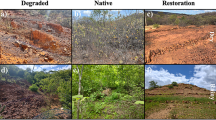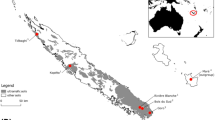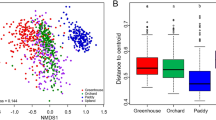Abstract
For centuries, biodiversity has spellbound biologists focusing mainly on macroorganism's diversity and almost neglecting the geographic mediated dynamics of microbial communities. We surveyed the diversity of soil bacteria and archaea along a steep precipitation gradient ranging from the Negev Desert in the south of Israel (<100 mm annual rain) to the Mediterranean forests in the north (>900 mm annual rain). Soil samples were retrieved from triplicate plots at five long-term ecological research stations, collected from two types of patches: plant interspaces and underneath the predominant perennial at each site. The molecular fingerprint of each soil sample was taken using terminal restriction length polymorphism of the 16S rRNA gene to evaluate the bacterial and archaeal community composition and diversity within and across sites. The difference in community compositions was not statistically significant within sites (P=0.33 and 0.77 for bacteria and archaea, respectively), but it differed profoundly by ecosystem type. These differences could largely be explained by the precipitation gradient combined with the vegetation cover: the archaeal and bacterial operational taxonomic units were unique to each climatic region, that is, arid, semiarid and Mediterranean (P=0.0001, for both domains), as well as patch type (P=0.009 and 0.02 for bacteria and archaea, respectively). Our results suggest that unlike macroorganisms that are more diverse in the Mediterranean ecosystems compared with the desert sites, archaeal and bacterial diversities are not constrained by precipitation. However, the community composition is unique to the climate and vegetation cover that delineates each ecosystem.
Similar content being viewed by others
Log in or create a free account to read this content
Gain free access to this article, as well as selected content from this journal and more on nature.com
or
References
Adler PB, Levine JM . (2007). Contrasting relationships between precipitation and species richness in space and time. Oikos 116: 221–232.
Ben-Dov E, Shapiro OH, Siboni N, Kushmaro A . (2006). Advantage of using inosine at the 3′ termini of 16S rRNA gene universal primers for the study of microbial diversity. Appl Environ Microbiol 72: 6902–6906.
Bowers MA, Thompson DB, Brown JH . (1987). Spatial-organisation of a desert rodent community—food addition and species removal. Oecologia 72: 77–82.
Bryant JA, Lamanna C, Morlon H, Kerkhoff AJ, Enquist BJ, Green JL . (2008). Microbes on mountainsides: contrasting elevational patterns of bacterial and plant diversity. Proc Natl Acad Sci USA 105: 11505–11511.
Carson JK, Campbell L, Rooney D, Clipson N, Gleeson DB . (2009). Minerals in soil select distinct bacterial communities in their microhabitats. FEMS Microbiol Ecol 67: 381–388.
Chaban B, Ng SYM, Jarrell KF . (2006). Archaeal habitats—from the extreme to the ordinary. Can J Microbiol 52: 73–116.
Clark J, Campbell J, Grizzle H, Acosta-Martinez V, Zak J . (2009). Soil microbial community response to drought and precipitation variability in the Chihuahuan Desert. Microb Ecol 57: 248–260.
Cornwell WK, Grubb PJ . (2003). Regional and local patterns in plant species richness with respect to resource availability. Oikos 100: 417–428.
Curtis TP, Head IM, Lunn M, Woodcock S, Schloss PD, Sloan WT . (2006). What is the extent of prokaryotic diversity? Philos Trans R Soc Lond B Biol Sci 361: 2023–2037.
Dunbar J, Ticknor LO, Kuske CR . (2001). Phylogenetic specificity and reproducibility and new method for analysis of terminal restriction fragment profiles of 16S rRNA genes from bacterial communities. Appl Environ Microbiol 67: 190–197.
Egert M, Friedrich MW . (2003). Formation of pseudo-terminal restriction fragments, a PCR-related bias affecting terminal restriction fragment length polymorphism analysis of microbial community structure. Appl Environ Microbiol 69: 2555–2562.
Fierer N . (2008). Microbial biogeography: patterns in the microbial diversity across space and time. In Zengler K (ed) Accessing Uncultivated Microorganisms: from the Environment to Organisms and Genomes and Back. ASM Press; Washington DC, pp 95–115.
Fierer N, Jackson RB. . (2006). The diversity and biogeography of soil bacterial communities. Proc Natl Acad Sci USA 103: 626–631.
Fisher MM, Triplett EW . (1999). Automated approach for ribosomal intergenic spacer analysis of microbial diversity and its application to freshwater bacterial communities. Appl Environ Microbiol 65: 4630–4636.
Fuhrman JA . (2009). Microbial community structure and its functional implications. Nature 459: 193–199.
Gardezi T, Gonzalez A . (2008). Scale dependence of species–energy relationships: evidence from fishes in thousands of lakes. Am Nat 171: 800–815.
Green J, Bohannan BJM . (2006). Spatial scaling of microbial biodiversity. Trends Ecol Evol 21: 501–507.
Grosskopf R, Janssen PH, Liesack W . (1998). Diversity and structure of the methanogenic community in anoxic rice paddy soil microcosms as examined by cultivation and direct 16S rRNA gene sequence retrieval. Appl Environ Microbiol 64: 960–969.
Hansel CM, Fendorf S, Jardine PM, Francis CA . (2008). Changes in bacterial and archaeal community structure and functional diversity along a geochemically variable soil profile. Appl Environ Microbiol 74: 1620–1633.
Hawkins BA, Field R, Cornell HV, Currie DJ, Guegan JF, Kaufman DM et al. (2003). Energy, water, and broad-scale geographic patterns of species richness. Ecology 84: 3105–3117.
Herman RP, Provencio KR, Herreramatos J, Torrez RJ . (1995). Resource islands predict the distribution of heterotrophic bacteria in Chihuahuan desert soils. Appl Environ Microbiol 61: 1816–1821.
Hoj L, Olsen RA, Torsvik VL . (2008). Effects of temperature on the diversity and community structure of known methanogenic groups and other archaea in high Arctic peat. ISME J 2: 37–48.
Ishii K, Fukui M . (2001). Optimization of annealing temperature to reduce bias caused by a primer mismatch in multitemplate PCR. Appl Environ Microbiol 67: 3753–3755.
Keil P, Simova I, Hawkins BA . (2008). Water-energy and the geographical species richness pattern of European and North African dragonflies (Odonata). Insect Conserv Divers 1: 142–150.
Kent AD, Triplett EW . (2002). Microbial communities and their interactions in soil and rhizosphere ecosystems. Annu Rev Microbiol 56: 211–236.
Lane DJ, Pace B, Olsen GJ, Stahl DA, Sogin ML, Pace NR . (1985). Rapid determination of 16S ribosomal RNA sequences for phylogenetic analyses. Proc Natl Acad Sci USA 82: 6955–6959.
Legendre P, Gallagher ED . (2001). Ecologically meaningful transformations for ordination of species data. Oecologia 129: 271–280.
Liu WT, Marsh TL, Cheng H, Forney LJ . (1997). Characterization of microbial diversity by determining terminal restriction fragment length polymorphisms of genes encoding 16S rRNA. Appl Environ Microbiol 63: 4516–4522.
Navarro-Gonzalez R, Rainey FA, Molina P, Bagaley DR, Hollen BJ, de la Rosa J et al. (2003). Mars-like soils in the Atacama Desert, Chile, and the dry limit of microbial life. Science 302: 1018–1021.
Nemergut DR, Costello EK, Meyer AF, Pescador MY, Weintraub MN, Schmidt SK . (2005). Structure and function of alpine and arctic soil microbial communities. Res Microbiol 156: 775–784.
Ochsenreiter T, Selezi D, Quaiser A, Bonch-Osmolovskaya L, Schleper C . (2003). Diversity and abundance of Crenarchaeota in terrestrial habitats studied by 16S RNA surveys and real time PCR. Environ Microbiol 5: 787–797.
Oline DK, Schmidt SK, Grant MC . (2006). Biogeography and landscape-scale diversity of the dominant crenarchaeota of soil. Microb Ecol 52: 480–490.
Robinson BS, Bamforth SS, Dobson PJ . (2002). Density and diversity of protozoa in some arid Australian soils. J Eukaryot Microbiol 49: 449–453.
Schlesinger WH, Raikes JA, Hartley AE, Cross AE . (1996). On the spatial pattern of soil nutrients in desert ecosystems. Ecology 77: 364–374.
Schloss PD, Handelsman J . (2006). Toward a census of bacteria in soil. PLoS Comput Biol 2: e92.
Schutte UME, Abdo Z, Bent SJ, Shyu C, Williams CJ, Pierson JD et al. (2008). Advances in the use of terminal restriction fragment length polymorphism (T-RFLP) analysis of 16S rRNA genes to characterize microbial communities. Appl Microbiol Biotechnol 80: 365–380.
SSSA (1996). Methods of Soil Analysis, Part 3. Soil Science Society of America: Madison, WI, USA.
Stahl DA, Amann R . (1991). Development and application of nucleic acid probes in bacterial systematics. In: Stackebrandt E and Goodfellow M (eds). Nucleic Acid Techniques in Bacterial Systematics. John Wiley & Sons Ltd Chichester: England, pp 205–248.
ter Braak CJF, Smilauer P . (1998). Canoco Reference Manual and User's Guide to Canoco for Windows. Centre for Biometry Wageningen: Wageningen, The Netherlands.
van Rensburg BJ, Chown SL, Gaston KJ . (2002). Species richness, environmental correlates, and spatial scale: a test using South African birds. Am Nat 159: 566–577.
Vishniac HS . (2006). A multivariate analysis of soil yeasts isolated from a latitudinal gradient. Microb Ecol 52: 90–103.
Walsh DA, Papke RT, Doolittle WF . (2005). Archaeal diversity along a soil salinity gradient prone to disturbance. Environ Microbiol 7: 1655–1666.
Woodcock S, Curtis TP, Head IM, Lunn M, Sloan WT . (2006). Taxa–area relationships for microbes: the unsampled and the unseen. Ecol Lett 9: 805–812.
Yergeau E, Newsham KK, Pearce DA, Kowalchuk GA . (2007). Patterns of bacterial diversity across a range of Antarctic terrestrial habitats. Environ Microbiol 9: 2670–2682.
Zhou J, Xia B, Treves DS, Wu LY, Marsh TL, O’Neill RV et al. (2002). Spatial and resource factors influencing high microbial diversity in soil. Appl Environ Microbiol 68: 326–334.
Zhou JZ, Xia BC, Huang H, Palumbo AV, Tiedje JM . (2004). Microbial diversity and heterogeneity in sandy subsurface soils. Appl Environ Microbiol 70: 1723–1734.
Acknowledgements
We gratefully acknowledge Diethart Matthies, Itamar Giladi and Suzanna K Remold for their help with the statistical analyses. We thank Eduard Jurkevitch and Zohar Pasternak for their insightful comments on the manuscript. Finally, we thank Fred A Rainey for introducing us to the topic.
Author information
Authors and Affiliations
Corresponding author
Additional information
Supplementary Information accompanies the paper on The ISME Journal website (http://www.nature.com/ismej)
Rights and permissions
About this article
Cite this article
Angel, R., Soares, M., Ungar, E. et al. Biogeography of soil archaea and bacteria along a steep precipitation gradient. ISME J 4, 553–563 (2010). https://doi.org/10.1038/ismej.2009.136
Received:
Revised:
Accepted:
Published:
Issue date:
DOI: https://doi.org/10.1038/ismej.2009.136
Keywords
This article is cited by
-
Differences in Precipitation Regime Shape Microbial Community Composition and Functional Potential in Namib Desert Soils
Microbial Ecology (2022)
-
Temperature and Precipitation Drive Elevational Patterns of Microbial Beta Diversity in Alpine Grasslands
Microbial Ecology (2022)
-
The responses of soil bacterial and archaeal communities to coastal embankments in three typical salt marshes of Eastern China
Plant and Soil (2022)
-
Bacterial diversity patterns of desert dunes in the northeastern Qinghai-Tibet Plateau, China
Archives of Microbiology (2021)
-
Azorella Cushion Plants and Aridity are Important Drivers of Soil Microbial Communities in Andean Ecosystems
Ecosystems (2021)



